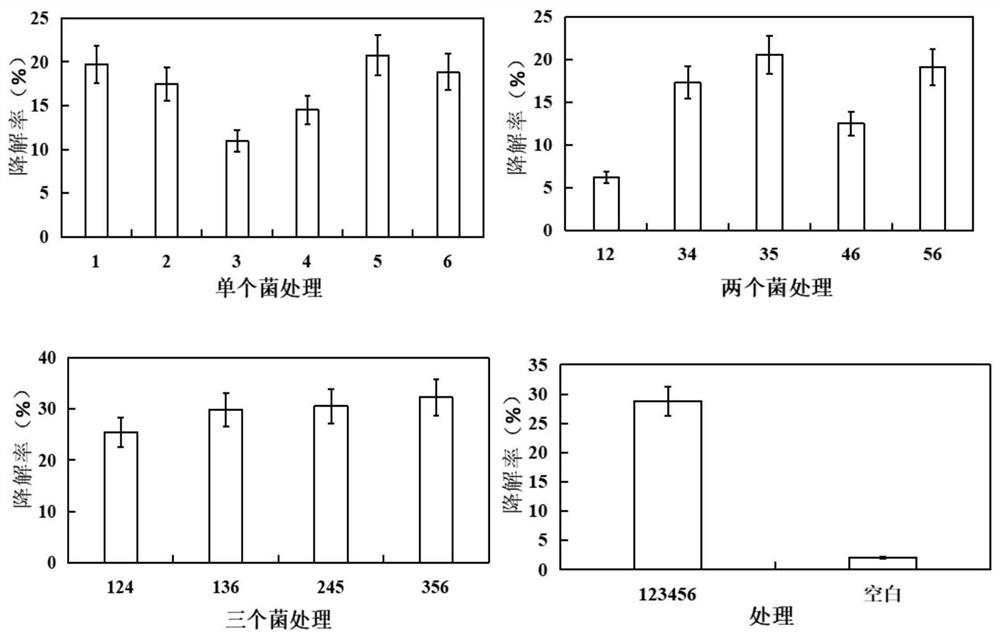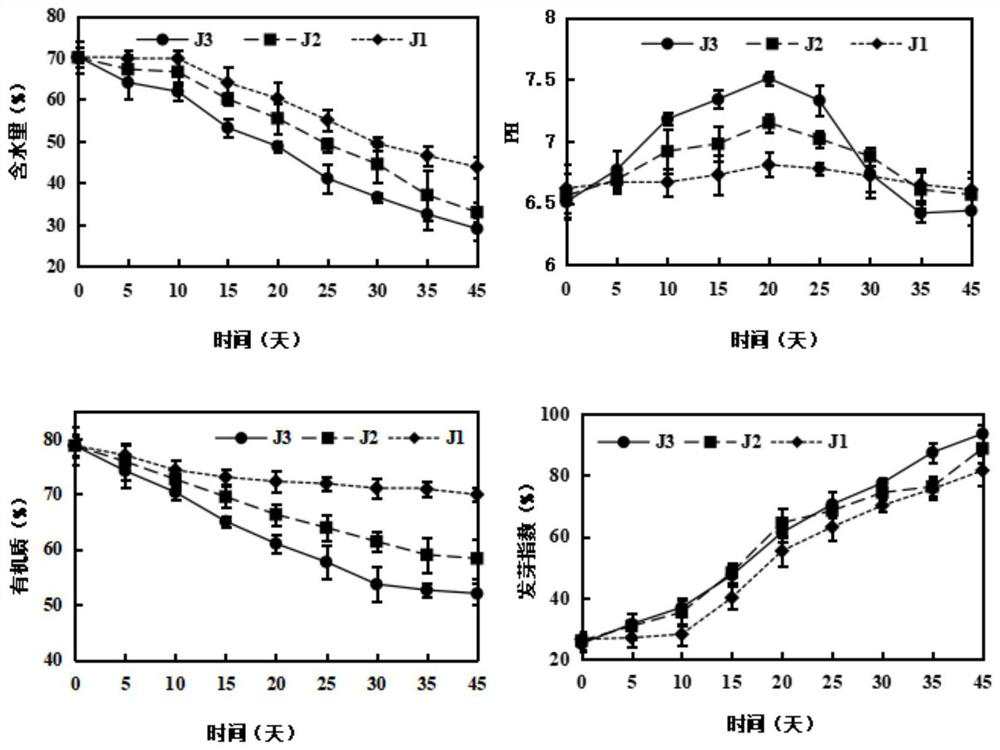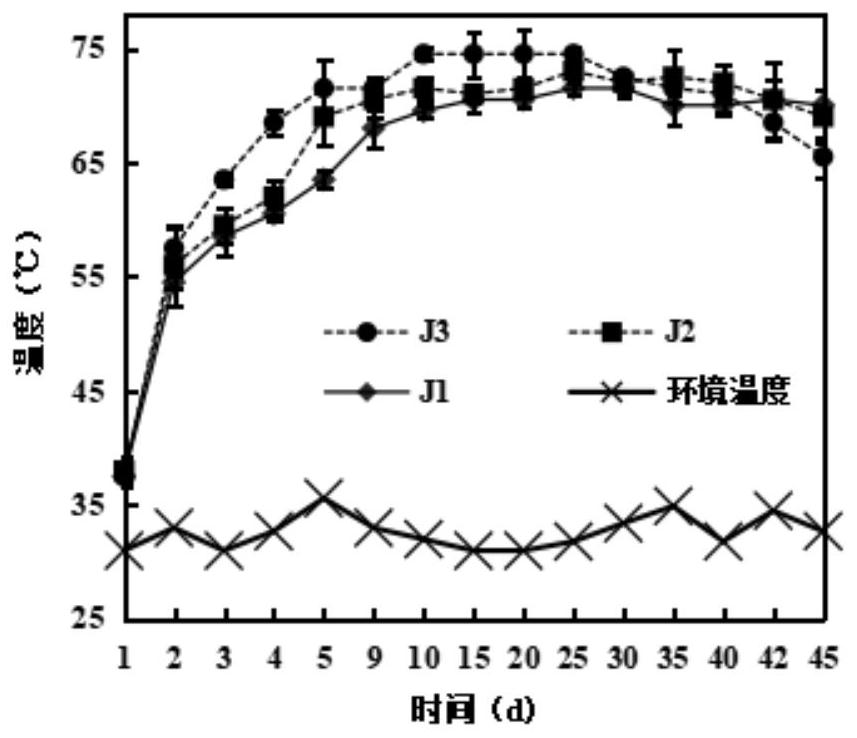A compound microbial agent for efficient degradation of lignocellulosic fibers and its application in composting
A compound bacterial agent and wood fiber technology, applied in the field of agricultural microorganisms, can solve the problems of insufficient degradation, complex composition of livestock and poultry manure and straw, and slow speed, so as to improve the economic benefits of enterprises and the ecological environment, and the synergy effect is obvious. , the effect of improving production efficiency
- Summary
- Abstract
- Description
- Claims
- Application Information
AI Technical Summary
Problems solved by technology
Method used
Image
Examples
Embodiment example 1
[0034]Implementation Case 1 Ability of Single Bacteria and Composite Bacteria to Produce Lignocellulose Degrading Enzymes
[0035] Enzyme activity kits (Suzhou Keming Biotechnology Co., Ltd.) were used to determine the enzyme activities related to the degradation of lignin and cellulose for both single and combined bacteria.
[0036] (1) β-glucosidase (β-GC) activity assay
[0037] β-glucosidase decomposes p-nitrobenzene-β-D-glucopyranoside to generate p-nitrobenzene, which has a maximum absorption peak at 400nm, and calculates β-glucosidase by measuring the rate of increase in absorbance vitality.
[0038] β-GC(nmol / min / ml)=(△A+0.0027)÷0.00543×V reverse total÷V sample÷T=61.39×(△A+0.0027)
[0039] (2) Determination of exo-β-1,4-glucanase (C1) activity
[0040] The content of reducing sugar produced by the degradation of microcrystalline cellulose catalyzed by exo-β-1,4-glucanase was determined by 3,5-dinitrosalicylic acid method.
[0041] C1(ug / min / ml)=1000×(△A+0.0673)÷6.4...
Embodiment 2
[0059] Example 2 Degradation Effect of Single Bacteria and Composite Bacteria on Straw
[0060] Weigh a certain amount of straw powder and place it in a 250ml triangular flask, absorb the same amount of bacterial solutions into the triangular flask, mix them evenly, put them in an incubator at 55 degrees for cultivation, and after 15 days, dry the samples and weigh them to obtain Straw without inoculation was used as a control, and the degradation rate of straw was calculated by weight loss method.
[0061] results and analysis
[0062] Effects of different bacterial flora combinations on straw degradation as follows: figure 1 shown. Among all single-bacteria treatments, No. 5 bacteria (NJAU-N20) had the highest degradation efficiency of 20.75%. In the combination of the two bacteria, the combination of bacteria No. 3 and No. 5 (NJAU-F4-5+NJAU-N20) had the highest degradation rate of 20.57%. Among the 3 bacteria combinations, the combination of bacteria No. 3, No. 5 and No...
Embodiment 3
[0064] Application of embodiment 3 functional bacteria in pure straw composting
[0065] The optimal single bacterium NJAU-N20 and NJAU-N30+NJAU-F4-5+NJAU-N20 compound bacterial agent screened out were used in the in-situ composting test of pure straw as raw material in the fertilizer factory of Ao Ganlin Co., Ltd., Leshan City, Sichuan Province. Three treatments were designed in the experiment: straw, straw+single bacteria, straw+combined bacteria, marked as J1, J2, J3 respectively.
[0066] Test procedure
[0067] 1. Raw material preparation: chop the corn stalks in the outdoor storage yard.
[0068] 2. Ingredients: add high-efficiency single bacteria and combined bacteria to the chopped corn stalks at a ratio of 1%. At this time, the initial water content of the straw group is 70%, and a control group without inoculation is designed.
[0069] 3. Cloth: Use a forklift to transfer the mixture to the fermentation bin for strip fermentation. After the cloth is finished, colle...
PUM
 Login to View More
Login to View More Abstract
Description
Claims
Application Information
 Login to View More
Login to View More - R&D
- Intellectual Property
- Life Sciences
- Materials
- Tech Scout
- Unparalleled Data Quality
- Higher Quality Content
- 60% Fewer Hallucinations
Browse by: Latest US Patents, China's latest patents, Technical Efficacy Thesaurus, Application Domain, Technology Topic, Popular Technical Reports.
© 2025 PatSnap. All rights reserved.Legal|Privacy policy|Modern Slavery Act Transparency Statement|Sitemap|About US| Contact US: help@patsnap.com



